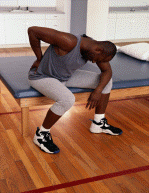Prevention and reversal of osteoporosis
can be accomplished! At the Kraus Back and Neck Institute (Houston,
Texas), we can
provide a specific program to help you fight and reverse this
silent disease.
DID YOU KNOW!!!?
- in the USA, we have one of the highest fracture rates in the world
- Singapore, Hong Kong, Yugoslavia, Bantu of South Africa and Japan
have extremely low rates of fractures
- Chinese and Japanese have lower bone mass than Western populations,
yet fewer osteoporotic fractures
- no signs of fractures were found among the Mayan Indians
- highest rates of fractures exist in the most prosperous and
technologically advances countries
- lowest rates exist in poorer, less technologically advanced
countries
- the United States has the highest spinal fracture rate in the world
- After the age of 35, each of us is losing bone mass, and is at
risk for osteoporosis
- Osteoporosis is a silent disease, until a fracture occurs
- 43 MILLION AMERICANS have LOW BONE DENSITY!!
- 10 MILLION AMERICANS have OSTEOPOROSIS!!
- 1 in 2 women, and 1 in 5 men will suffer an osteoporosis related
fracture
- there will be 700,000 spine and 300,000 hip fractures in the USA
this year
- BILLION OF DOLLARS ARE SPENT YEARLY ON Fosamax, Zometa, Evista,
Boniva, Actonel, Miacalcin, Vitamin D, and calcium
- Certain exercises, if done an appropriate manner,
can prevent or reverse osteoporosis
- There are things which we can do to prevent and
reverse osteoporosis!!
If the above statistics are concerning to you, they should be. What
is impressive is not only how prevalent and debilitating this silent disease
of osteoporosis is, but the fact that by doing the right things, it can be
prevented or reversed, even after one has suffered a fracture related to
osteoporosis. Osteoporosis is the most common bone disease in humans,
and it dramatically affects people in the United States. Much
attention is given to the treatment of Osteoporotic Compression Fractures,
but a huge focus should be on the prevention. At the Kraus Back and
Neck Institute, Dr. Kraus treats a large number of patients with
Kyphoplasty , a
technique which enables a neurosurgeon / spine surgeon the ability to place
cement within the fractured vertebral body, to increase its' height and
stabilize the fracture, thus reducing pain. This type of procedure is
performed frequently, as there are 700,000 compression fractures of the
spine which occur yearly in the United States alone.
Kyphoplasty is a
procedure which attempts to fix a problem, rather than prevent it. It
does an excellent job at reducing pain in individuals suffering from spinal
compression fractures. At the Kraus Back and Neck Institute, the
philosophy of preventing disease as well as treating disease, prevails.
There is no question that this silent disease can be treated, reduced, or
reversed, before it becomes problematic. At the Kraus Back and Neck
Institute, attention is devoted to reducing the impact of osteoporosis on
the lives of people in the United States and abroad.
There is significant evidence to that that osteoporosis related fractures
increase morbidity and mortality. Osteoporosis represents a serious problem for those residing in the
United States, and throughout the world. The effects of this crippling
disease (osteoporosis) are very prevalent in the United States, and
significantly increase the mortality and morbidity among the population.
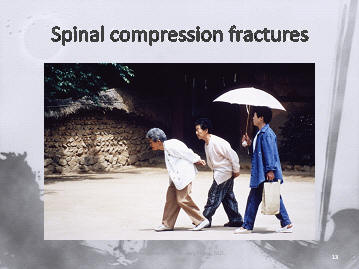
Above, three generations of a Korean family are seen. Notice the
kyphotic (stooped forward) posture of the most elderly. Below, we see
in graphic form, what has happened to the spine to cause this kyphotic
posture.
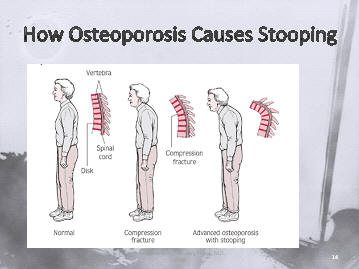
The most common areas of fractures related to osteoporosis are the spine,
the femur, and the wrist.
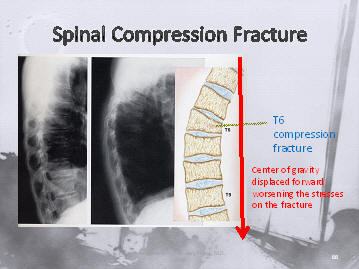
Once a compression fracture of the spin occurs, the next level is more
likely to suffer a compression fracture. This is because the center of
gravity of the body has shifted forward, thereby placing more stress upon
the adjacent vertebral bodies. When the next compression fracture
occurs, the situation worsens, and the increasing cascade of risk to
adjacent levels continues.
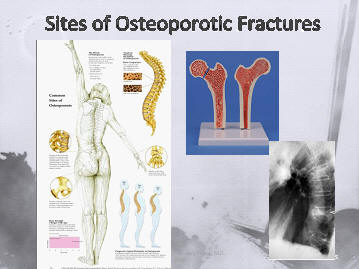
A few staggering facts about osteoporosis force us to realize how much of
an impact it makes on our lives. After the age of 30 - 35, when we
achieve our peak bone mass, each of us loses bone mass, and therefore bone
density.
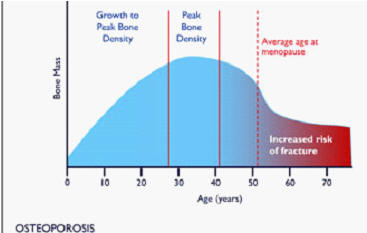
This year, roughly 700,000 Americans will suffer a spinal fracture
related to osteoporosis. In addition, 300,000 Americans will suffer a
hip fracture which is related to osteoporosis. These types of
fractures are much less common in many areas around the world than they are
in the United States. Even healthy astronauts, in the weightlessness
of space for short periods of time, lose bone density.
Osteoporosis is a silent disease, and usually remains silent until
someone suffers a fracture related to it. It can be prevented, and can
be diagnosed and treated before a fracture occurs. Even after the
first fracture does occur, future factures may be prevented.
10 million Americans have osteoporosis. 43 million Americans have
low bone density. 1 in 2 women and 1 in 5 men will suffer an
osteoporosis related fracture.
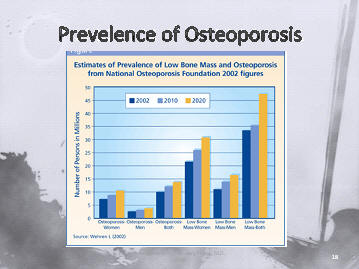
As we see from the graph above, the prevalence of osteoporosis is
increasing, and as the number of people in America over the age of 50
increases, so will the number of Americans with osteoporosis.
The Economic Impact of osteoporosis is staggering. In the United
States, on a yearly basis, there are 432,000 hospital admissions; 2.5
million medical office visits; 180,000 nursing home admissions. In
2005, $17 BILLION was spent on treatment of this disease. In fact,
hospitalizations for osteoporotic compression fractures outnumbered
those due to MI (myocardial infarction), breast cancer or prostate cancer.

Billions of dollars are spent each year on Fosamax, Zometa, Evista,
Boniva, Actonel, Miacalcin, Vitamin D, and calcium in order to prevent or
reverse osteoporosis.
In order to better understand osteoporosis, we must understand a number
of basic facts related to osteoporosis. Each of our bodies is
constantly replacing many of the cells within the body. We are
constantly replacing skin cells, liver cells, and bone cells. In fact,
every 3 months, much of the tissue in our bones is replaced. Bone is a
living substance, which may be a surprise to some.
Bone loss begins in one's mid to late 30's. In women, bone loss
accelerates at menopause. Over a lifetime, women lose 38% of their
total peak bone mass, and men lose 23%.
Bone provides a number of functions for our bodies. First, it keeps
us erect. Without the lattice of bones to keep us upright, there would
be nothing to keep us off the ground. Bone provides protection.
The ribs protect our lungs, and the skull protects our brain. Bone
provides the ability for us to locomote. It allows us to use legs to
transport out bodies. Bone also produces our blood cells. 2.4
million red blood cells are produced by 9 ounces of bone marrow. In
addition, bone acts as a mineral bank for the body. Most of the body's
calcium (99%), 85% of the phosphorus, 60% of the magnesium, and 35% of the
sodium are stored in bones. These minerals provide strength to the
bone, and also act as a mineral bank for the rest of the body to draw upon.
The minerals which are stored in bone are critical for normal functioning
of the body. Calcium is needed for regular heart rhythms, for proper
nerve conduction, and for the ability of our blood to clot. Phosphorus
is used for our bodies energy production, and for creation of DNA
(deoxyribonucleic acid) and RNA (ribonucleic acid). Magnesium is
needed for nerve and muscle fucnction, and for acid/base balance.
As mentioned above, bone is a living structure. 22% of bone is
living collagen protein matrix, which provides a certain degree of
flexibility to bone. Collagen requires certain substances, such as
amino acid proline, vitamin c, sulfur, copper, zine, manganese and boron for
its production. Likewise, factors such as steroids, NSAIDS
(non-steroidal antiinflammatory medications) can damage the collagen
connective tissue.
The architecture of bone consists of two portions, the cortical or
compact bone, which is the tough outer covering of bone, and the trabecular
or cancellous bone, which is the spongy honeycomb interior of bone. Most of
the cortical bone (80-90%) is calcified, whereas only 15-25% of the
cancellous bone is calcified.
In order to appreciate why and which bones in the body fracture as a
result of osteoporosis, we need to understand what type of bone exists, and
where it does, within the body. The vertebral bodies, which comprise
the spine, are mostly cancellous blocks of bone, surrounded by a shell of
cortical bone. Since they contain mostly cancellous bone, which is
subject to weakening with osteoporisis, these vertebral bodies are very
susceptible to fracture. The bones making up the lower part of the
wrist are also susceptible to fracture. The ribs, jaw, and hips are at
risk of fracture, as well.
Since bone is alive, it is constantly changing. Two types of cells
do the work of bone. Osteoblasts are cells which lay down new bone.
Osteoclasts are cells which break down bone. The process of
osteoblastrs creating bone, and osteoblasts breaking it down, are two
delicately balanced processes. When the breakdown rate exceeds the
formation rate, bone loss and therefore osteoporosis occurs.
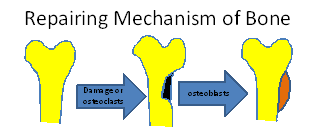
Every day, bones in our body are changing in shape and design. Bone
remodels itself according to the stresses and strains we place upon it in
our daily lives. Bone remodels itself to provide strength, but it is
not heavier than it needs to be. It becomes stronger in response to
stress, exercise, and stronger muscle.
What is the meaning of osteoporosis? Translated, it means:
osteo = bone; porosis = porosity. Thus, it means porous
bone. Below are microscopic pictures of normal bone (left) , and
osteoporotic bone (right). Notice that the bone with osteoporosis
(right) has fewer bridging trabeculae, and the ones which are present in the
osteoporotic bone, are much thinner.

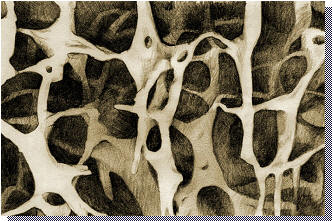
To standardize what is meant by bone density, the WHO (World Health
Organization) has created the following definitions. A person with a
bone density of 1 standard deviation or less below the young adult reference
range, is considered to have normal bone density. A person with a bone
density of of 1 to 2.5 standard deviations below the young adult reference
range is considered to have low bone density, also known as osteopenia.
A person with a bone density of more than 2.5 standard deviations below the
adult reference range, is considered to have osteoporosis. And a
person with bone density of more than 2.5 standard deviations below the
young adult reference, with the presence of one or more bone fractures, is
considered to have severe osteoporosis.
The following graph shows the decrease in bone density after the age of
35.
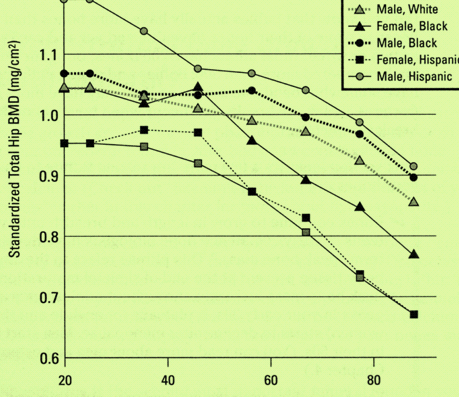
It is interesting to note that the fractures which patients with
osteoporosis suffer, are related to more than just the density of bone.
Although the elderly in France, Germany, China and Japan have low bone
density, they suffer fewer fractures related to osteoporosis than do those
in the United States. In Japan, the consumption of calcium is less
than in the United States, and the hip bone density is less, yet the
Japanese suffer 2.5 times less hip fractures than do those people in the
United States.
It is a misconception to think that osteoporotic fractures are due solely
to the thinning of bones. There are many people who have osteoporosis,
yet suffer no fractures. The elderly in France, Germany, China, Japan
have lower bone densities than many in the United States of America, yet
they suffer fewer osteoporotic fractures. The Japanese hip density is
much less than in the United States, and the Japanese consume much less
calcium that we do, yet they have 2.5 times fewer hip fractures than in the
USA.
It appears that what sets us up for fractures is 1) weak bone
architecture, and 2) poor self repair capability, which is the inability to
repair the microfractures which occur on a daily basis.
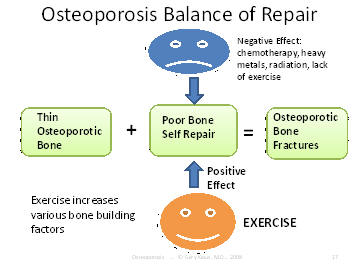
As we can see from the figure above, there are positive and negative
influences upon bone repair. When thin osteoporotic bone undergoes
microfractures, it tries to repair itself. Exercise increases various
bone building factors, which aid in the healing process and recover of bone
from fractures. On the other hand, chemotherapy, radiation, and a
sedentary lifestyle hinder the ability of bone to repair itself.
What is interesting and concerning at the same time, is that the United
States has one of the highest osteoporosis fracture rates in the world.
In Singapore, Hong Kong, Yugoslavia, and the Bantu of South Africa, rates of
fractures related to osteoporosis are extremely low. The Chinese and
Japanese have lower bone mass that their Western counterparts, yet have far
fewer fractures. The Mayan Indians have virtually no fractures.
World wide hip fracture rates vary 30 fold for women, and 16 fold for men.
The highest rates occur in the most prosperous and technologically advanced
countries, and the lowest rates occur in the poorer, less technologically
advanced countries.
American women over the age of 65, have a 25-33% chance of having a
vertebral fracture. By age 80, most suffer a fracture.
Osteoporotic fractures are also becoming a disorder of the young, afflicting
younger individuals who have poor nutrition, and those who have had surgery
to remove and ovary and/or uterus.
Osteoporosis can be considered to be an intelligent design of the body.
It serves as a bank of minerals and nutrients for the body. It
therefore replensishes essential minerals and nutrients which may be missing
from the body. But, when these minerals and nutrients are not
replaces, the bone itself becomes osteoporotic. Other factors which
negatively influence osteoporosis are lifelong patterns of poor eating, lack
of exercise, smoking, irregular periods, medication use, and toxic exposure.
As can be seen from the above information, exercise can help prevent
osteoporosis, and can reverse bone which is already suffering from
osteoporosis. Besides helping osteoporosis, exercise can help with the
following: heart disease, hypertension, stroke, colon lung and breast
cancer, diabetes, low back pain, obesity, depression, and anxiety.
Harvard alumni who performed sports with moderate intensity had a 25%
lower chance of dying from any cause. A 16 year Norwegian study showed
that the most physically fit men had half chance of dying from any cause,
compared to the least physically fit.
The bottom line is that exercise builds bone. Placing strain on
bone maintains bone mass, and is critical in preventing bone loss, or
gaining bone mass. Bone density is greater in those whose jobs require
physical exertion, than in those with sedentary jobs. It is important
to realize that nutrition cannot cannot bring maximum peak bone mass, or
maintain bone mass. EXERCISE IS REQUIRED!!
We find that patients who have a paralytic syndrome, or are immobilized
from casts, there is rapid atrophy of bone and muscles during prolonged
bedrest. In fact, one week of bed rest equates to a 1% loss of lumbar
spine mass. Weightlessness by astronauts in space causes bone loss.
In general, bone mass equals muscle mass. When we lose muscle, we
lose bone. Skeletal strength correlates with total muscle mass.
Weight and resistance training is a very good way to build muscle mass.
Lean body mass (muscle) is the best indicator of bone density.
According to the National Osteoporosis Foundation, "National Osteoporosis
Foundation strongly endorses lifelong physical activity at all ages, oth for
oeteoporosis prevention and overall health, as benfeits are lost when the
person stops exercising....Muscle strengthening exercise includes weight
training and other resistive exercises. Before an individual with
osteoporosis initiates a new vigorous exercise program, such as running or
heavy weight lifting, a clinician's evaluation is appropriate."
Further, the National Osteoporosis Foundation states "progressive
resistance training and increased loading exercises, within the parameters
of the person's current health status, are beneficial for muscle and bone
strength."
Osteoporosis Recommendations for Clinicians (National
Osteoporosis Foundation)
counsel patient on the risks of osteoporosis as well as the related
fractures
evaluate for other (secondary) causes of osteoporosis
counsel on the use of sufficient amounts of calcium
calcium 1200 mg / day
vitamin D (800 - 1000 IU per day)
supplements for individuals over 50
exercise to consist of weight bearing and muscle strengthening exercises
to decrease risk of fractures
avoid tobacco smoking and excessive use of alcohol
for women over 65 and men over 70, bone mineral density testing
bone mineral density testing for postmenopausal women and men age 50-69
when concerned about risk profile
bone mineral density testing in patients who have had a fracture
start therapy when bone mineral density score is less than -2.5 at
femoral neck or spine by DEXA study
Begin treatment in postmenopausal wome and men age 50 or older when they
have low bone mass (T score -1.0 to -2.5: osteopenia) at femoral neck or
spine and a 10 year hip fracture probability of over 3%or a 10 year major
osteoporosis related fracture probability of over 20%.
at present, the options approved by the FDA for osteoporosis prevention
and treatment are biphosphonates (ibandronate, risedronate, alendronate and
zoledronic acid), calcitonin, estrogen and hormone therapy, parathyroid
hormone (teriparatide) and estrogen agonist / antagonist (raloxifene)
bone mineral density testing two years after starting pharmacologic
therapy, and every two years thereafter
To Prevent or Reverse Osteoporosis
Each of us can increase our bone density with resistance training.
At the Kraus Back and Neck Institute, we have developed a
program to help treat and prevent osteoporosis. A program is
specifically designed to address the weaknesses and needs of an individuals
body, and maximize efforts to strengthen bone.
If you would like to participate, please contact the
Kraus Back and Neck Institute at 281-870-9292.
Treatment of osteoporosis as it relates to the spine
is performed in Houston Texas at the Kraus Back and Neck Institute.
There are three offices in Houston Texas which are conveniently located on
the medical campuses of West Houston Medical Center (Houston, Texas), and Memorial Hermann
Memorial City Hospital (Houston, Texas), as well as in Katy, Texas. The Kraus Back and
Neck Institute serves patients in the Houston area, surrounding areas in
Texas, as well as other states in the United States, and abroad.
Please contact us at 281-870-9292, to help with your travel and hotel
arrangements.
For more information on treatment and prevention of osteoporosis and osteoporotic
fractures, contact the Kraus Back and Neck
Institute (Houston, Texas).
|

